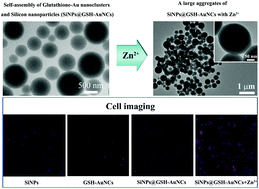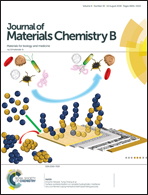Ratiometric detection of Zn2+ and Cd2+ based on self-assembled nanoarchitectures with dual emissions involving aggregation enhanced emission (AEE) and its application†
Abstract
Glutathione–Au nanoclusters (GSH–AuNCs) are known as typical luminophores with aggregation-induced emission (AIE) features, which can be triggered by low temperature, low pH values, and metal ions. However, these strict “triggers” restrict the application of this AIE probe under mild and neutral conditions. In this work, fluorescent amino-modified silicon nanoparticles (SiNPs) and GSH–AuNCs can self-assemble into well-designed nanospheres through electrostatic interactions under physiological conditions. The hybrid probe of SiNPs@GSH–AuNCs exhibits dual emissions located at 450 nm from SiNPs and 570 nm originating from the aggregation enhanced emission (AEE) of GSH–AuNCs. Interestingly, the addition of Zn2+ or Cd2+ can connect the nanospheres to form large aggregates, so a unique second increase of AEE from GSH–AuNCs appears, while the emission of SiNPs remains constant to act as an internal reference. The fluorescence ratios (I570/I450) of SiNPs@GSH–AuNCs are positively correlated with Zn2+ or Cd2+ with the linear range from 1.5 μM to 500 μM. Most importantly, besides the advantages of dual emissions, high fluorescence brightness, and good stability, the SiNPs@GSH–AuNCs also exhibit excellent biocompatibility and low cytotoxicity, and have been successfully applied in zinc imaging in live cells. Furthermore, the proposed method is also used to measure Zn2+ and Cd2+ in real samples with satisfactory recoveries.



 Please wait while we load your content...
Please wait while we load your content...